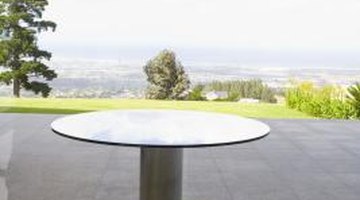How to Cut Down a Round Kitchen Pedestal Table to Make a Coffee Table
Up-cycle a kitchen pedestal table by transforming the piece into a chic coffee table to last for years to come. Choose a sturdy table with a wood pedestal base for the project. Bring a friend over to assist you and enjoy the finished piece the same day. Although this can be a quick project, take the time to work through each step carefully to keep the integrity of the piece.

Step 1

Turn table onto its top. Locate all screws and brackets connecting the tabletop to the pedestal base. Remove bolts, screws or latches to separate the top from the stand. Be careful to avoid stripping the screws, as you will need to reattach the top at a later time. Place all small items removed into a plastic baggie to avoid losing any pieces.
Step 2

Measure the new desired height of the pedestal. Mark the desired line to cut. Measure each side of the pedestal twice to avoid error. Prepare to cut the piece by clearing a safe space and wearing proper safety attire. Use a table saw or other tool to cut the excess height from the top of the pedestal stand. Cut the first side and rotate the stand to make additional cuts. Treat a rounded stand as if it were square by making small "side" cuts and rotating the base. Check for a correct cut by placing the level on top of the pedestal stand. If uneven, adjust by using a measuring square and measuring tape to mark the correct line and make additional cuts.
Step 3

Sand the cut area of the pedestal to create a smooth connection for the table top. Place the base back onto the upside-down tabletop. Measuring distances to the tabletop edges centers the base. Locate the previous connection holes on the underside of the tabletop as a guide. Using the attachment devices removed in the first step, attach the brackets or other connectors to the tabletop before drilling new holes into the base. Secure the connections. Drill coinciding holes on the base stand attachment. Screw the base to the attachment brackets.
Step 4
Finish the project by flipping the table onto its base and verifying the stability. Check for an even tabletop by using the level or square. Correct any errors by tightening or loosening screws as needed. Overtightened brackets can pull the table off center or cause it to lean. Instability may require additional brackets if the original attachments are worn. Add a coat of paint or a fresh layer of wood stain and sealer to complete the project.
Tips
- Use new connection brackets if the table is old.
- Practice straight cuts on wooden dowels before attempting to cut the base.
- Measure twice and cut once.
Warnings
- Use proper safety attire and an assistant when using power tools.
Writer Bio
Based near St. Louis, Mo., Beth Ortega started her writing career in 2004 creating training programs for national companies. She brings her expertise as a small-business owner, restaurateur, designer and personal trainer to her writing. She holds a license in financial planning from Kaplan University and an Associate of Science in business management from University of Phoenix.
Photo Credits
- Goodshoot/Goodshoot/Getty Images
- Comstock/Comstock/Getty Images
- Photos.com/Photos.com/Getty Images
- Photos.com/AbleStock.com/Getty Images
More Articles
- How to Make a Replacement Rocking Chair Runner
- How to Make a Replacement Table for a Radial Arm Saw If You Don't Have the Original
- How to Build a Corner Kitchen Nook out of Old Church Pews
- How to Lower the Height of a Table
- How to Install Concrete Balustrades
- How to Remove Scuff Marks From Tile Floors



